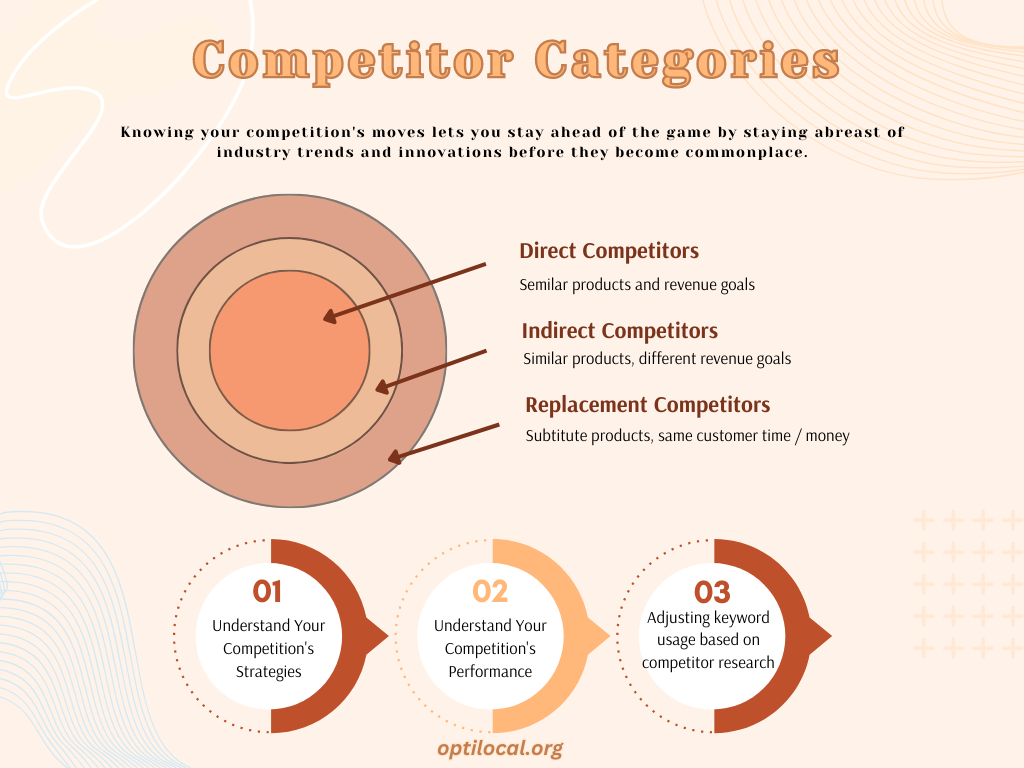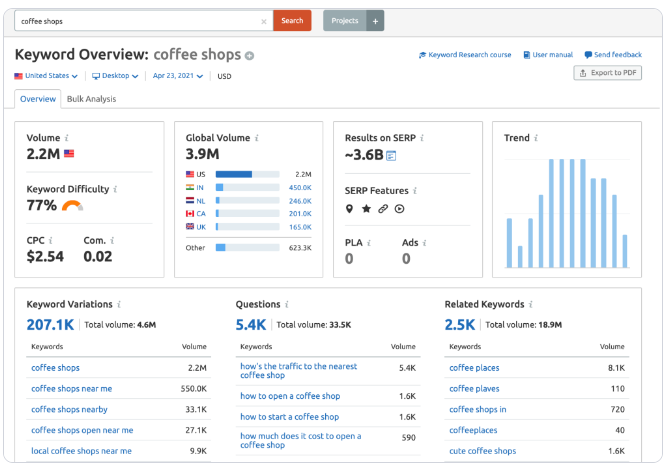Are you looking to find competitor categories in your Google Business Profile? Exploring competitor categories in a Google Business Profile is necessary to optimize visibility and outshine competitors.
By utilizing some investigation, shrewd advertising plans, and a few information examination instruments, you can acquire profitable experiences into what makes your rivals fruitful.
This article will explore how to analyze your competition with Google My Business Insights, build an effective local SEO plan based on market trends, monitor performance metrics over time, and adjust accordingly.
So let’s get started.

More Resources :
What are Competitor Categories ?
Competitor categories are a group of businesses that offer similar products or services to the same target audience. Identifying competitor categories can help local businesses better understand their competitive landscape and develop effective strategies for success.
Defining competitor categories involves understanding who your competitors are, what they offer, and how they compare to your business regarding pricing, customer service, product quality, etc.
By looking at these factors you can determine which companies fall into the same category as yours and therefore should be considered direct competitors.
By understanding the competitive landscape, businesses can gain a deeper insight into what strategies they should use to best market their product or service.

Benefits of identifying competitor categories
It includes gaining valuable insights into customer needs and preferences, uncovering gaps in the market that you could capitalize on, crafting targeted messaging that resonates with customers, gauging how competition affects prices, keeping tabs on changes in competitors’ offerings over time, and more. Knowing your competition’s moves lets you stay ahead of the game by staying abreast of industry trends and innovations before they become commonplace.
By analyzing competitor categories in Google Business Profile, you will have the information needed to decide how best to compete in the local market.
Analyzing Your Competition
Competition analysis is an important part of any local SEO strategy. By understanding your competitors’ strategies and performance, you can gain insights into what works and what doesn’t, allowing you to optimize your approach for maximum success.
It’s essential to understand your competitors’ tactics to stay ahead of them. Analyze their website content, keywords in their titles and descriptions, backlinks acquired, and how they use social media platforms such as Facebook or Twitter. By understanding the tactics employed by your competitors, you can replicate them in your campaigns and gain an advantage.
Once you have identified the strategies your competition employs, it’s time to evaluate their performance against yours regarding search engine rankings, traffic data from analytics tools, customer feedback on reviews sites, website updates, and social media presence. Analyze search engine rankings for pertinent keywords over time; review traffic data from analytics tools; assess customer feedback on reviews sites; keep tabs on competitor websites for updates; monitor social media platforms – these activities will give you a comprehensive view of how each company is faring in terms of marketing efforts.
Once competitor research has been conducted, utilizing the results to modify keyword usage can be a powerful tool in targeting local customers who may not know your brand but recognize product categories or nearby services. Adjusting keyword usage based on competitor research can be extremely effective when targeting local customers who may not be familiar with brand names but recognize product categories or nearby services. Additionally, monitoring reviews across various sites provide valuable insight into customer sentiment, which can be addressed through improved service offerings or communication methods if necessary; ultimately leading to more satisfied customers who remain loyal longer term.
Optimizing Your Google Business Profile for Local SEO
Optimizing your Google Business Profile for local SEO is essential to ensure you reach the right customers and stay ahead of the competition. Crafting a complete and exact profile is vital, giving prospective customers a concept of what they can anticipate from your business. It’s important to include all relevant information, such as contact details, location, opening hours, services offered, images, and videos.
Leveraging reviews and ratings on sites like Google My Business (GMB) is also important for boosting visibility since these are seen by prospective customers who may be researching local businesses before making a purchase decision.
Remember that optimizing for local SEO requires ongoing effort; set up alerts for rankings or traffic levels changes so that any necessary adjustments can be made quickly. Tracking performance metrics over time will provide valuable insights into how effective certain strategies have been at driving traffic and conversions. Monitoring customer interactions with your listing on GMB Insights will help you identify areas where improvements could be made.
Utilizing Google My Business Insights for Market Research
Google My Business (GMB) Insights provides a wealth of data that can be used to inform your local SEO strategy. By exploring the dashboard, you can gain insights into customer interactions with your business listing, track performance metrics over time, and analyze the impact of changes on performance. The GMB Insights dashboard is divided into three main sections: Overview, Customers & Actions, and Performance.
By utilizing GMB Insights to explore customer interactions with your business listing, you can identify which keywords they’re using when searching for it online or what types of posts attract them most often – allowing you to adjust content accordingly based on user behavior patterns.
Building an Effective Local SEO Strategy
Building an effective local SEO strategy is essential for businesses seeking to gain visibility. Here are some key elements to do this:
It involves creating content that appeals to both customers and search engines alike. This includes writing blog posts about topics related to the business’s services or products and optimizing existing pages with location-specific keywords like city names or zip codes. Businesses should also look into producing videos and podcasts that focus on their target audience’s interests while incorporating relevant keywords.
It requires taking into account factors such as page titles, meta descriptions, headings (H1-H6), images alt tags, and URLs, all of which need to be optimized with appropriate location-specific terms such as city names or zip codes where appropriate. It’s also important that businesses create separate web pages targeting different cities they serve to rank higher in those areas.
A successful local SEO plan is essential for businesses wanting to enhance their appearance in the search engine results pages and draw more clients.
Monitoring and Adjusting Your Local SEO Efforts
Monitoring and adjusting your local SEO efforts is essential for staying ahead of the competition. Setting up alerts for changes in rankings or traffic allows you to stay informed about what’s happening with your website, so you can quickly respond to any changes that could impact performance. Assessing the effects of such modifications ensures that any alterations are based on facts rather than mere speculation.
To configure notifications, begin by establishing a Google Search Console profile if you don’t possess one already. This will allow you to monitor keyword rankings and other important metrics related to organic search visibility. Use analytics tools like Google Analytics or Adobe Analytics to track website traffic from organic search and paid campaigns.
It’s also important to evaluate the impact of any adjustments made after monitoring performance metrics over time—whether they’re related to content optimization, link-building strategies, or other tactics used in local SEO campaigns. Make sure all adjustments are made strategically based on results from monitoring activities; avoid making random changes without first understanding their potential implications on overall performance within SERPs and across digital channels. For instance, instead of adding more keywords to page titles, analyze whether those words appear frequently enough in user queries before implementing them – and adjust accordingly depending on the findings.
FAQs about How to Find Competitor Categories in Google Business Profile
Conclusion
Creating a successful local SEO approach is critical for any organization wanting to make an impact in its regional area. By analyzing your competition, optimizing your Google Business profile, and utilizing Google My Business Insights for research, you can gain valuable insights into what works best when targeting potential customers. Additionally, by monitoring and adjusting your efforts regularly, you can stay ahead of the competition and find competitor categories in your google business profile that is most relevant for driving traffic toward your website or store location.
Let OptiLocal help you find and capitalize on competitor categories in your Google Business Profile. Our experienced team of local marketing professionals will provide the insights and strategies to ensure success.
